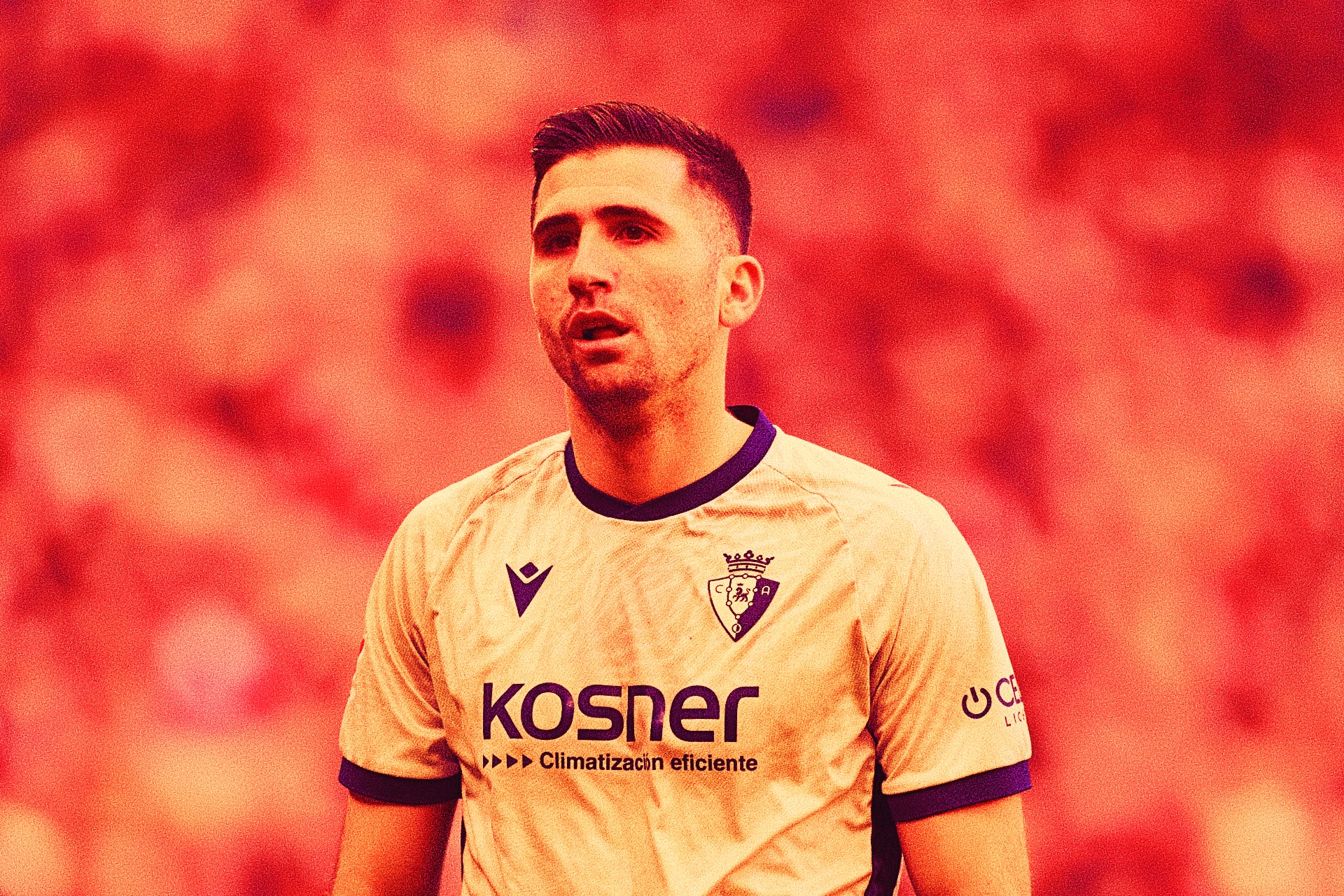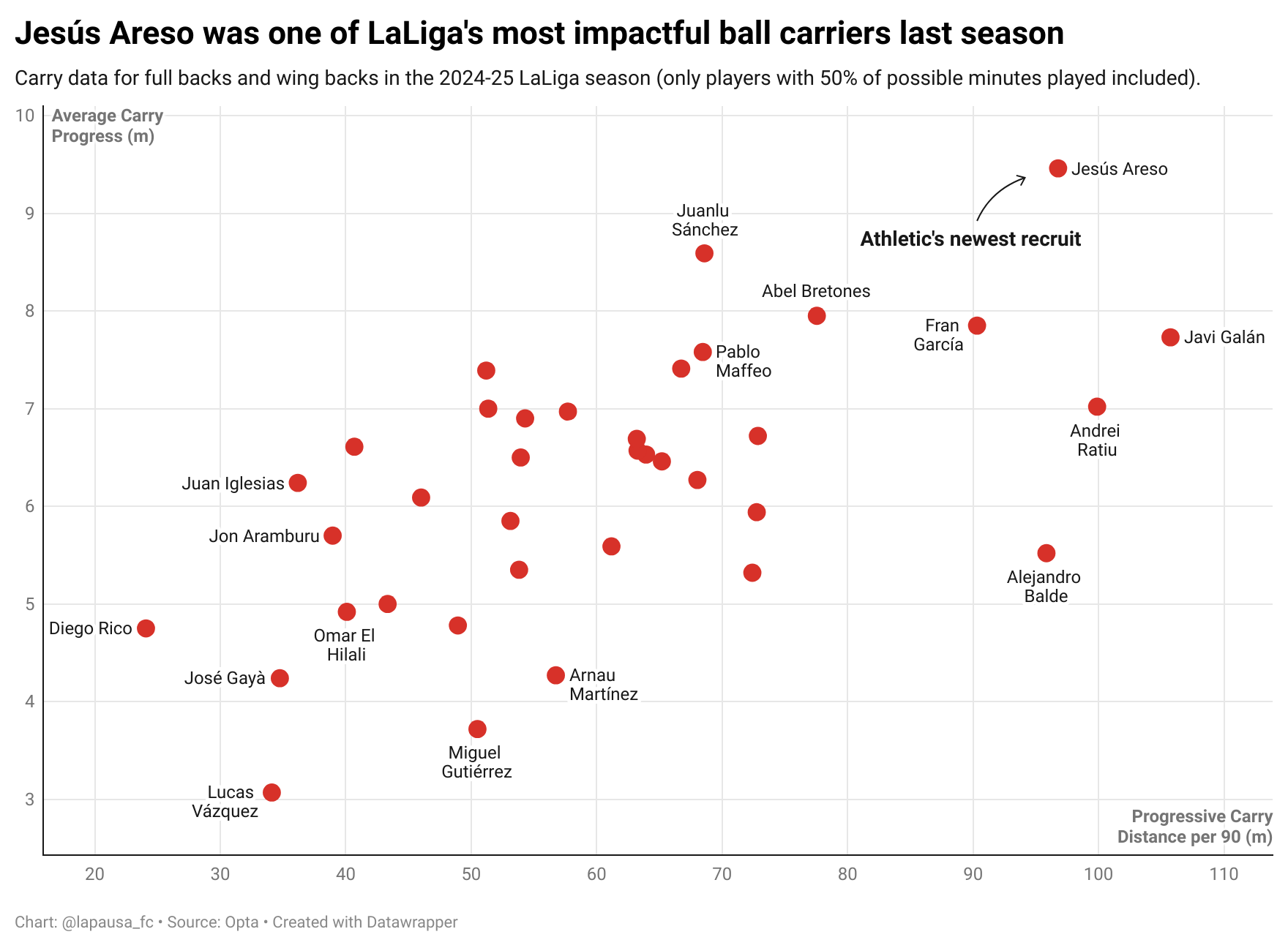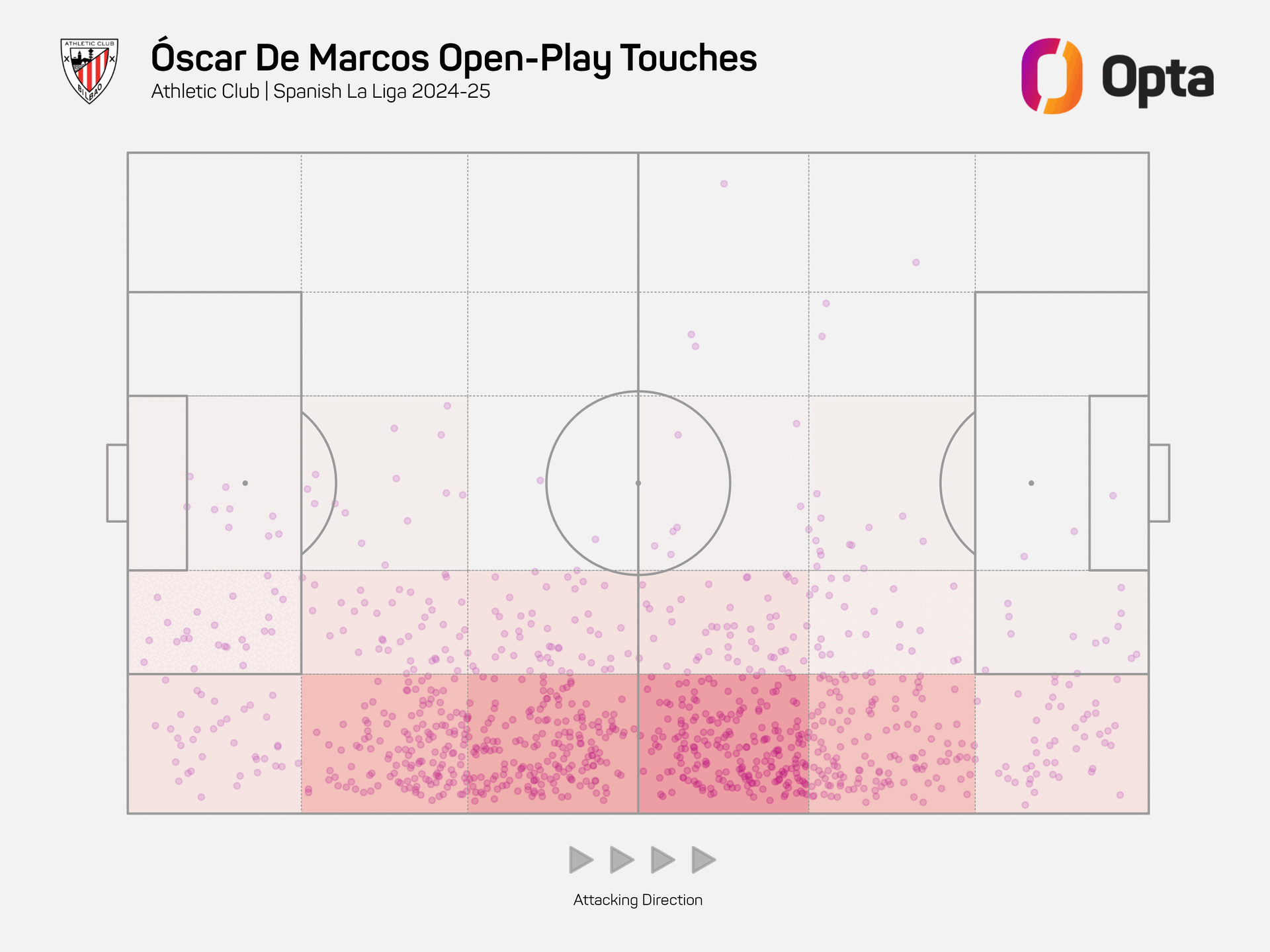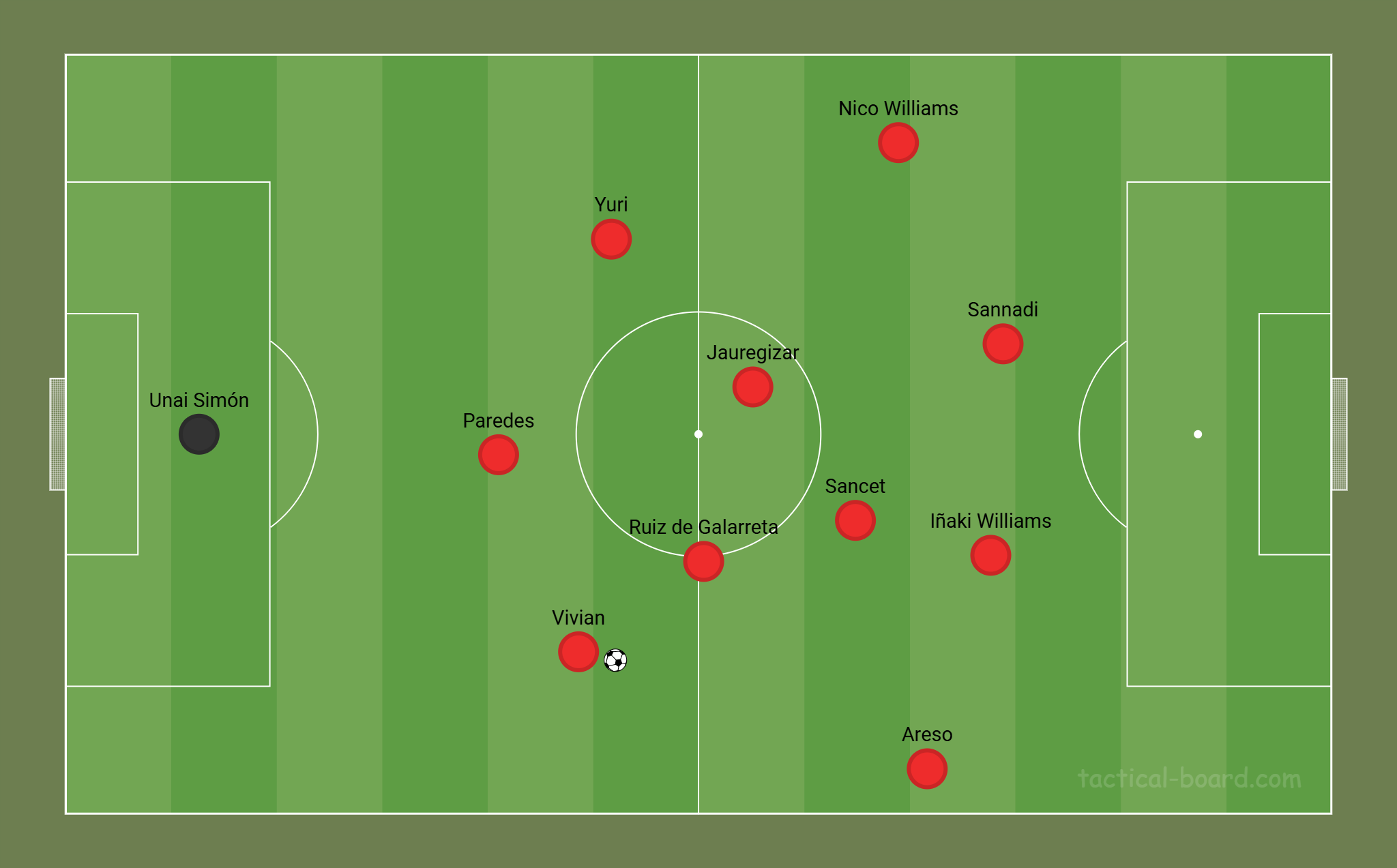Jesús Areso arrives on time for Athletic
Following the retirement of Óscar De Marcos, the 26-year-old returns to a scene of his youth with a prime opportunity to make it last.
Jesús Areso had just put the finishing touches on a fine individual season, while Óscar De Marcos was putting the finishing touches on a fine individual career.
In retiring from professional football at the end of the 2024-25 season, De Marcos’s exit would open up a convenient spot for Areso; one of few standout players in LaLiga who wasn’t currently playing for Athletic but eligible to meet their club policy, should they wish to sign him.
To the surprise of almost nobody, they did. It was a transfer you could see coming from many miles away. And so Areso returns ‘home’, back to a place he played in his youth but where he never managed to make the definitive leap to the first team. It sounds like a nice story as far as personal redemption goes, but in the context of Athletic Club, it’s all a fairly normal part of their life cycle. Players arrive, develop, either make the grade or leave, but their names aren’t forgotten.
At Athletic — perhaps to an extent you won’t find anywhere else in world football — the door really is never closed. When your club policy willingly reduces the scope of individuals that can play for you, it pays to be less definitive even with those you plan to discard in the short term. You never know when you might need them.
Areso left the club just before his 22nd birthday and now returns aged 26, following three seasons at Osasuna and one on loan at Burgos in the second tier. In Athletic’s case, you could even say things have gone to plan. Though they play their part in player development, they know when the potential route back for that individual might only be able to occur once they’ve left, found a new environment and secured opportunities that didn’t exist to shape the rest of that ‘development’.
Think the likes of Gorka Guruzeta or Iñigo Ruiz de Galarreta — who played for an astonishing seven different clubs in between his spells — as recent examples of those who not only returned after leaving without much fanfare, but became essential pieces in one of the best teams they’ve had this century.
All in all, the equation for Athletic is pretty simple. There comes a point when a player who’s gone away finally piques their interest, and when it’s combined with dynamics like a positional opening or market opportunity, the story resumes.
That’s precisely the case with their latest recruit, too.
🚅 Athletic’s freight train adds another gear
Ernesto Valverde’s Athletic are a swarming football team. They squeeze you, limit your space to play, and punch hard if you cough up the ball. Over the last few seasons, it’s a scene we’ve seen repeated over and over again: opposition teams (mostly at San Mames) unable to find any air and succumbing to wave after wave of short, punchy attacks. They’ve made more high turnovers (1,059) than every other team in LaLiga since Valverde’s return in 2022.
At their best, Athletic are a nightmare cocktail of hard-running and direct football, capable of spooking even the highest quality of opposition.
The same description could be used in some ways for Jesús Areso. He’s a flyer of a full back who gobbles up open ground, and a player you can rely on to go end-to-end at full clip for 90 minutes. Without needing to be perfectly precise with the ball all the time, you can already picture how the stock version of Areso’s game is going to put even more thrust behind Athletic’s downhill style of play. Indeed, the most basic fact of all is that they’ve traded out a 36-year-old at the end of his career for a 26-year-old who spent all of last season galloping up and down pitches in LaLiga with just about as much gusto as anyone in the country.
Put Yuri Berchiche and Nico Williams on one side; Jesús Areso and Iñaki Williams on the other, and you have a wing setup that is going to apply masses of forward pressure, even on their bad days.
One of the advantages of bringing Areso back at this stage of his career is that he clearly knows what his strengths are and where his advantages lie, without overcomplicating things. For the 26-year-old, that typically means running hard with and without the ball (see graphic above).
It might sound basic, but it’s plenty effective. As we saw last season, Areso feeds on a steady diet of bursting runs — with and without the ball — to aid quick forward moves and apply pressure on the penalty area. Those become especially dangerous in moments after the opposition have turned possession over, where his driving style can rapidly make the most of displaced teams and find its way into advantageous areas. And whether they end in a considered cross or a mere flash across the box, it will all serve as welcome attacking volume for an Athletic team who value momentum and waves of pressure.
The clip below from last week’s friendly at PSV is a prime example of Areso’s attacking game. In his time away from Athletic, he’s gone about refining this steady series of moves to spark attacking openings from the wing, usually revolving around give-and-go combinations and overlapping runs beyond/underneath his winger.
The annoying part for opponents is how hard Areso commits to those efforts. Not only moving after the pass, but launching into full-on sprints even if only to garner some attention, ought to be a hugely valuable asset for Athletic next season. It’s precisely the type of thing opposition wingers don’t want to have to deal with (and they probably won’t get away with clear shirt pulls like the above in the regular season.)
Areso’s attacking game isn’t reinventing full back play any time soon, but he knows how to get the most out of it. Nor is it a slight to categorise his impact as more physical than it is technical. Much like Athletic themselves, his productivity in attack is built on insistence and repetition of attacks, rather than waiting for the perfect moment to commit.
The full back’s game achieves that too — or at least, it did in spades for Osasuna last season. Areso was was one of only four full backs in LaLiga last season with 20+ open play chances created, 20+ open play successful crosses and 20+ completed dribbles (along with Miguel Gutiérrez, Pablo Maffeo and Johan Mojica).
When a full back like that comes up on the market for a team in Athletic’s situation, it’s a deal you simply have to make.
❓Shift in role and how Athletic shape up
Compare the roles of Jesús Areso and Óscar De Marcos last season and it’s pretty clear that one was more offensive than the other. Like many modern day full backs, Areso often looked like an orthodox winger in his positioning — and he did also play a notable amount of games as a wing back in a 3-5-2 system in the second half of the campaign.
Will Athletic adapt for Areso, or will he have to adapt to his new side? The answer is probably a mixture of both.
It’s possible that Athletic opt for continuity of role, given that De Marcos — despite his age — was a fantastic athlete in his own right. Less explosive than his replacement, but a marathon man nonetheless. And Areso has the ability to still join attacks with later runs from deep, as he showed with Osasuna last season. Covering ground at speed is no problem for him.
We could, however, see a more aggressive use for Athletic’s right back next season. Namely, through a higher starting position. With the rise of back fours turning into back threes in possession these days, it’d be no surprise if Valverde looked to Areso as his main source of width on the right, and compensated by holding Yuri deeper on the other side when Areso is high and wide.
While not a permanent scene throughout matches — Areso isn’t always going to be high and wide — it would allow Iñaki Williams to attack the defensive line from inside (a key strength of his) and give him a dynamic full back partner to combine with. It would limit him receiving passes in isolation on the wing, which isn’t ideal for him at this stage of his career, while his intelligence and run-making is arguably at its peak.

As for the other Williams, the possibility of Athletic having a dangerous outlet on the right who plays high and wide can only be good news. Being able to stretch the pitch on both sides with two players who can sustain threat in the attacking third in distinct ways means better spacing of the pitch. Opponents have to be better in how they’re shifting across, where metres can make all the difference. And in Nico’s case, it’s likely to be his side where teams make more of an effort to crowd him out and limit space.
If that results in easier switches of play and more room for Areso to operate in on the right side — and he can show he’s a threat to be respected too — that improves the conditions for both of them.
As far as balancing the team goes, should Areso earn a particularly advance role, the formula looks pretty well achievable for Athletic. Their starting central midfielders are two of the best counter-pressers in LaLiga, while the right side of their back line is held up by possibly the best recovery defender in the country, in the form of Dani Vivian. If Ernesto Valverde could pick any centre back in LaLiga to play behind an ambitious full back, he might well pick Vivian.
Further to that, it’s logical to think Yuri Berchiche could be used as more of a third centre back next season. Although he’s a well-rounded full back, Valverde will no doubt be considering the fact that the 35-year-old is going to be under plenty of demand in a season where Champions League football is coming onto their calendar. Can they still use him as a full back flyer given that fact, as well as the arrival of a player in Areso who’s almost a decade younger?
It’s not as if that slight change of role for Yuri would be a dramatic one — we saw him do so in spells and certain games last season, as well as in early pre-season action this time round. Indeed, when you have Nico Williams in front of you, sometimes the best thing you can do is give him the ball and stay deep out of the way (so as not to encourage a winger back into the vicinity).
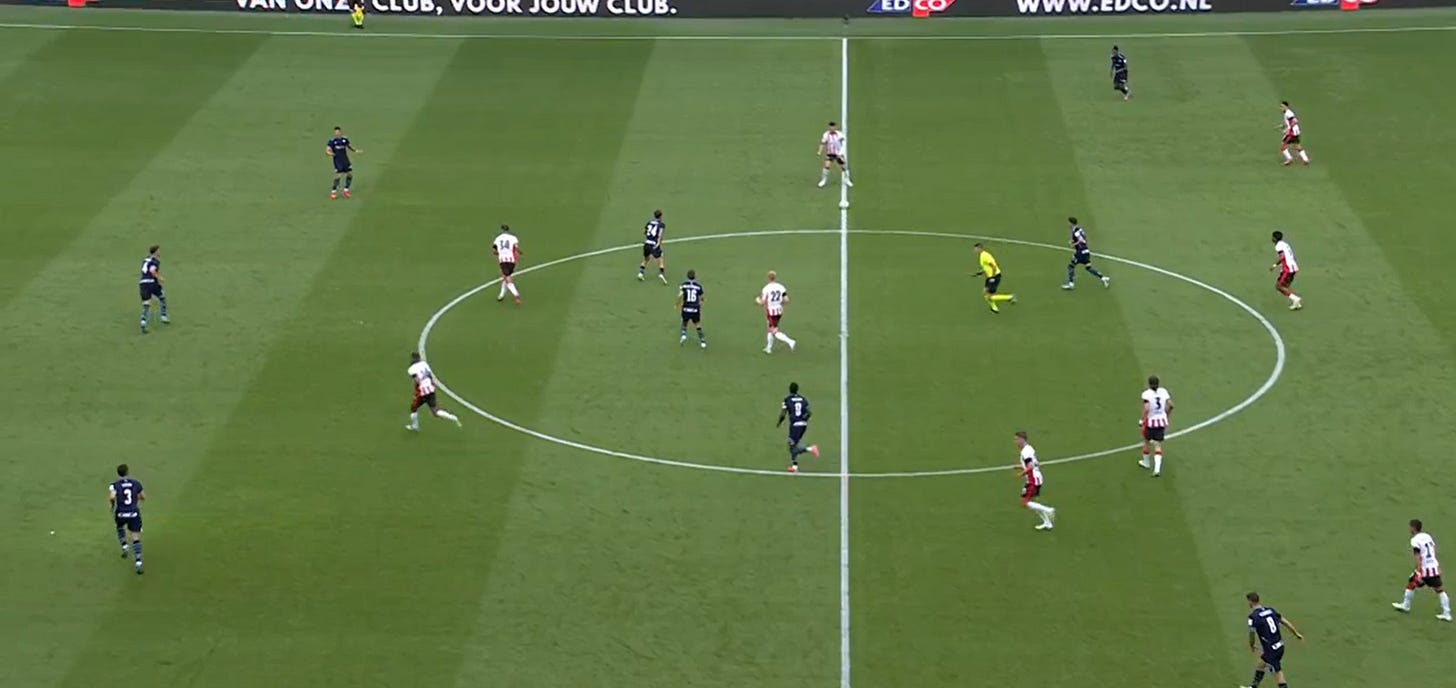
In summary, the signing of Jesús Areso is one that Athletic will have made with plenty of faith in what he can give them in attack. Though he’s no doubt got the ability to be a strong two-way defender, the real excitement will come through what he can provide to a team who can already overwhelm teams with their direct, physical style of play — even before the arrival of one of LaLiga’s most potent wing marauders.
In a season where Athletic face a significant challenge to stay in the top four race while competing in the Champions League and Copa del Rey, the adaptation and impact of Areso could be a significant factor in that pursuit. Adding a new dimension to an attack that has managed to retain Nico Williams would be a tremendous development for all concerned.




